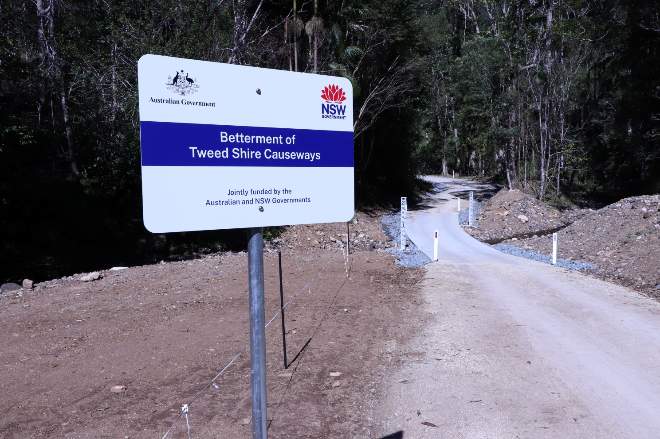 |
New bridges are being built, some timber bridges are being replaced with culverts, and multiple causeways are receiving upgrades as part of a multi-million dollar program in the Tweed to improve resilience against flooding on our roads.
Up to 35 causeways and culverts across the Tweed Shire will be upgraded as part of the Regional Roads and Transport Recovery Package, a jointly funded Australian and NSW Government program under the Disaster Recovery Funding Arrangements (DRFA).
The 2 governments have approved more than $22 million for these projects to limit the impacts of future extreme flood events across the shire.
Work started in April and will largely be carried out by local contractors, as well as Tweed Shire Council work crews. They are expected to be completed by late next year, weather permitting.
Council Director Engineering, Tim Mackney said the Tweed has been fortunate to be part of the betterment funding arrangements, and the benefits will be with the community for years to come.
"This is another example where Council has made the most of external funding to assist the Tweed to be more resilient to the challenges of climate change," Mr Mackney said.
"One of our major projects will be the reconstruction of Blacks Drains on Tweed Valley Way at South Murwillumbah. The major design and construction work will increase resilience against natural disasters and improve the site's functionality in future floods."
Causeways to receive funding include:
- Midginbil Road, Midginibil - causeway replacement
- Booka Road, Upper Crystal Creek - causeway replacement
- Numinbah Road, Chillingham- concrete pavement
- Byrrill Creek Road, Byrrill Creek - causeway replacement, pavement stabilisation and barrier modification
- Rowlands Creek Road, Rowlands Creek- new culvert
- Commissioners Creek Road, Commissioners Creek - concrete approaches and new culvert
- Crooks Valley Road, Crystal Creek - new culvert
- Kerrs Lane, Pumpenbil - new culvert and concrete causeway
- Urliup Road, Urliup - culvert repairs and approach slabs
- Tunnel Road, Stokers Siding - concrete approach slabs and flexible pavement
- Tweed Valley Way (Blacks Drain), South Murwillumbah - concrete pavement and embankment protection
- Ophir Glen Rd, Upper Burringbar - bridge deck replacement
- Mount Warning Road, Mount Warning - concrete approaches
- Cedar Creek Road, Cedar Creek- upgrade timber bridge
- Geles Road, Upper Burringbar - replace timber bridge with concrete bridge
- Burringbar Road, Upper Burringbar - replace timber bridge with concrete bridge
- Crabbes Creek Road, Crabbes Creek - replace culverts and new causeway
- Everinghams Road, Pumpenbil - additional cross drainage pipe
- Glengarrie Road, Tomewin - additional cross drainage pipe
- Reserve Creek Road, Reserve Creek - additional cross drainage pipe and replace timber bridge with concrete culvert
- Cobaki Road, Cobaki - pavement stabilisation
- Dungay Creek Road, Dungay- concrete approach
The NSW Minister for Recovery and North Coast, Janelle Saffin said she was pleased Tweed Shire Council has recognised these important routes and is using betterment funding to help keep them open in future events.
"We often take the road and transport network for granted, but that attitude changes when those networks are disrupted by flooding or other natural disasters," Ms Saffin said.
"These critical pieces of infrastructure keep communities connected, they provide access to crucial medical facilities, food and other everyday needs and help keep our agricultural and businesses running."
Federal Minister for Emergency Management Kristy McBain said:
"All of Australia saw the damage done to Tweed Shire and other parts of the Northern Rivers during the devastating flooding of early 2022, so it's pleasing to see all the work that's now underway to make the region more resilient against future events.
"When completed, this work will keep the community safer, allow it to get back on its feet sooner after a natural disaster and avoid much of the social and economic cost that goes with extreme events.
"We can't prevent those from happening, but we can be better prepared, and that's what this work does."






